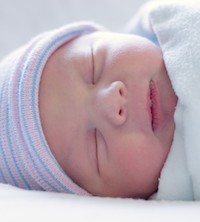Researchers concludes that acupuncture is successful for the treatment of infertility.  A clinical trial was conducted at the Department of Acupuncture and Moxibustion at Ruikang Hospital, an affiliate of Guangxi University of Chinese Medicine. A total of forty cases were invested using a standard treatment protocol of electroacupuncture combined with moxibustion. The effective rate for the treatment regime was 85% based on the pregnancy rate in a follow-up visit with the 40 members of the study.
A clinical trial was conducted at the Department of Acupuncture and Moxibustion at Ruikang Hospital, an affiliate of Guangxi University of Chinese Medicine. A total of forty cases were invested using a standard treatment protocol of electroacupuncture combined with moxibustion. The effective rate for the treatment regime was 85% based on the pregnancy rate in a follow-up visit with the 40 members of the study.
The researchers measured the effects of acupuncture and moxibustion on anovulatory infertility, a type of infertility caused by the lack of ovulation. Following the treatment regime, FSH, LH and E2 levels improved. In addition, the thickness of the endometrium increased and the follicle diameter increased. The significant results achieved in the successful pregnancy rate combined with these objective findings led to the researchers’ conclusion that acupuncture and moxibustion successfully enhance fertility for women with anovulatory infertility.
Electroacupuncture and moxibustion were applied to Zigong (EX-CA-1), CV4 (Guanyuan) and Zhongji (CV3). An additional choice of acupuncture points was made with the Ling Gui Ba Fa method. Ling Gui Ba Fa, translated as the eightfold method of the sacred tortoise, is a method for choosing effective acupuncture points selected from the eight confluent points of the eight extraordinary vessels based on the time of day. This method is based on the theory of the nine palaces and eight trigrams to determine acupuncture points that are most effective for a given period of time. The earliest account of the Ling Gui Ba Fa method is found in the Zhen Jiu Zhi Nan, A Guide to Acupuncture and Moxibustion, written by Dou Hang-qing in the Jin dynasty. The eight confluent points, which are the palette of point selection, are SP4, P6, SI3, UB62, GB41, TB5, LU7 and KI6. More conventional methods employ the standard use of differential acupuncture channel diagnosis and indications to select from these acupuncture points.
In other research, investigators concluded that acupuncture was able to improve “menstrual frequency and decrease circulating androgens in women with polycystic ovary syndrome (PCOS).” Infertility is an unwanted complication associated with some forms of PCOS, polycystic ovarian syndrome, and acupuncture showed significant clinical improvements in the women studied.
Another study published in the American Journal of Physiology – Endocrinology and Metabolism concludes that low frequency electroacupuncture improved menstrual frequency and balanced sex steroid levels in women with PCOS. The study measured improvements in a wide range of endocrine variables such that the researchers concluded that electroacupuncture may help induce ovulation in women attempting to conceive since participants showed significant improvements in monthly menstrual frequency. Interestingly, there are similarities in the acupuncture point selection in this study with the study of women with anovulatory infertility.
Acupuncture was applied to CV3, CV6, ST29, SP6, SP9, LI4, and P6. All needles were stimulated manually until a de qi sensation was achieved. Thirty minutes of 2 Hz electro-acupuncture was applied to CV6, CV6, ST29, SP6 and SP9 for each treatment. LI4 and P6 were manually stimulated every 10 minutes to evoke sensation. Needle length ranged from 30 to 50mm and the diameter was 0.32mm. Needle depth ranged from 15 to 35mm. Acupuncture was administered twice per week for two weeks, one time per week for six weeks and once every other week for eight weeks for a total of 14 acupuncture treatments over a 16 week period.
References:
XU, Yin, and Miao ZHANG. "Efficacy observation on 40 cases of anovulatory infertility treated by acupuncture and moxibustion." World Journal of Acupuncture-Moxibustion 23, no. 1 (2013): 40-43.
Electrical and manual acupuncture stimulation affects estrous cyclicity and neuroendocrine function in a DHT-induced rat polycystic ovary syndrome model. Yi Feng1,2, Julia Johansson1, Ruijin Shao1, Louise Mannerås Holm1, Håkan Billig1, Elisabet Stener-Victorin1,3 . Experimental Physiology. DOI: 10.1113/expphysiol.2011.063131.
Elizabeth Jedel, Fernand Labrie, Anders Odén, Göran Holm, Lars Nilsson, Per Olof Janson, Anna-Karin Lind, Claes Ohlsson, and Elisabet Stener-Victorin. Impact of electro-acupuncture and physical exercise on hyperandrogenismand oligo/amenorrhea in women with polycystic ovary syndrome: a randomized controlled trial. Am J Physiol Endocrinol Metab 300: E37–E45, 2011.


